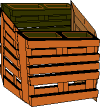|
Composting is a natural process that breaks down kitchen, lawn and garden materials into a dark, earthy, soil-like material called "compost." This end-product is an excellent soil conditioner for plants, gardens and lawns. 
Why compost???
-Composting provides a free, top-notch soil conditioner that improves plant, garden and lawn growth.
-Compost acts like a sponge, helping soil retain moisture and nutrients.
-Compost helps break down heavy clay soils or helps to bind sandy soils.
-Soils rich in compost experience less erosion and reduced quick runoff.
-By returning nutrients back into the soil, compost reduces the need for expensive chemical fertilizers.
-Composting household materials will save landfill space. The amount of waste you send to the landfill will be reduced by 1/3 to 1/2.
-It's easy! You don't need any technical knowledge or equipment.
What do you need for composting??
The basic elements needed for composting are:
organic materials (food)
air
water all in the right amounts.
To add efficiency, you will also need:
a container for collecting kitchen scraps;
a pitchfork, shovel or other turning device;
and a bin for your backyard.
Materials to compost
All organic (compostable) material contain a mixture of carbon and nitrogen, this is know as the carbon:nitrogen (C:N) ratio. For best results your compost pile requires a balance of carbon and nitrogen, with the optimum being 30:1.
Items containing carbon are generally brown in colour, such as autumn leaves or straw. Items containing nitrogen are generally green in colour, such as kitchen scraps and green grass clippings.
A rule of thumb is to have roughly equal amounts of browns (carbon) and greens (nitrogen). This is known as the 50/50 rule and will balance the carbon:nitrogen ratio at the proper level.
The following is a list of some of the different green and brown materials that can be composted. It is not a complete list. Other materials may be added.
Greens... Nitrogen Rich
These materials are usually moist.
green leaves
weeds before they go to seed
vegetable/fruit peels and scraps
spoiled food
green grass clippings
coffee grounds, including the filter
tea bags
egg shells (crushed)
breads
cooked pasta and rice
flowers
Browns...Carbon Rich
These materials are usually dry.
evergreen needles
dry leaves
dried brown grass clippings
bark chips
straw
prunings and cuttings
dryer/vacuum lint
hair
bird cage cleanings
cardboard/paper*
sawdust*
* These items should be used in limited quantities because they decompose slowly. |
